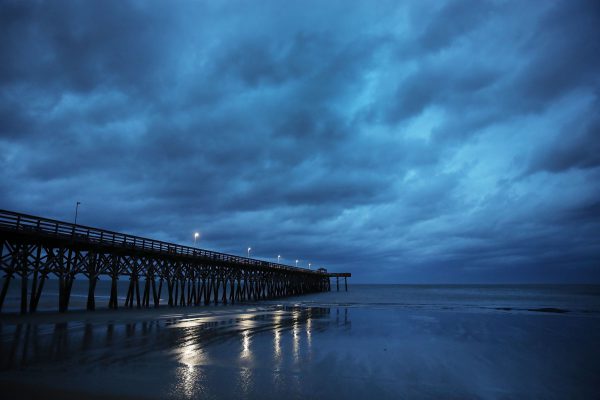by Rebecca Boyle – source: medium
As Hurricane Florence makes landfall, scientist eyes are looking to the skies

It may not be visible on the sodden Eastern Seaboard, but far above Hurricane Florence’s lashing winds and rain, the crescent moon is waxing—and that’s bad news for flooding along the Carolina coast.
Through its gravitational tug, the moon is the primary driver of the Earth’s tides—the daily rising and sinking of the oceans and lakes. High tides are higher than usual in the days around a new or full moon. As wind and rain from Hurricane Florence began pelting North Carolina, the moon’s cycle was just four days old, which means higher tides than average for America’s eastern shores. It also means the storm tide—the term for rising waves brought on by rainfall and surging seawater—will be higher too.
“If you could choose when to get hit by a hurricane, you would want it to be at a low tide,” said Brian McNoldy, a hurricane researcher at the University of Miami, who explained that to reduce the storm tide as much as possible, you want hurricanes to hit—if they must—during the first quarter or third quarter moon, “as far opposite of a new or full moon as you can get,” he said. Unfortunately, the recent new moon is still influencing tides in the Carolinas and in the Miami area.
The moon’s influence may not be obvious to most people, especially those who don’t live near coasts. But it shouldn’t be underestimated.
The moon’s shape appears to change in the sky with each consecutive night because of its alignment with respect to the Earth and sun. When the moon sidles in between the two, we can’t see light reflected off the moon’s surface, and it is invisible to us. That’s a new moon. During this phase, the sun and moon line up on the same side of Earth, so the sun amplifies the moon’s gravitational pull. The water on our planet bulges toward the moon more dramatically, and tides can be significantly higher.
Here’s what that means for Florence: As the effects of the hurricane slammed into the coast Thursday, Sept. 13 (the eye of the storm reached the coast on Friday morning), the moon was four days past new and 240,100 miles away, pretty close to its average distance from Earth. The scenario is not great news for the storm surge and storm tide, according to McNoldy.
The last megastorm to besiege the Carolinas was Hurricane Hazel in 1954. That storm had terrible timing, making landfall during a full moon high tide, bringing an 18-foot storm surge. Hurricane Sandy made landfall in New York City in 2012, also during a full moon, which may have contributed to higher than usual storm-surge levels. Hurricane Florence poses an even greater threat because it is expected to stall along the coast, dumping rain on the Carolinas for days on end. If the storm is as slow-moving as predicted, “it’s going to be there for two or three high tides,” McNoldy said.
Scientists are still trying to work out just how high the water will rise, where it will rise, and for how long. Storm surges—the abnormal rise in sea levels and, often, the deadliest effect of a hurricane—depend on numerous things, like a storm’s strength, speed, and direction; the terrain, coastline shape, and inlet size; the warmth of the water; and even the continental shelf on the ocean floor.
If you could choose when to get hit by a hurricane, you would want it to be at a low tide.
While the moon is partly to blame for high tides, there is one very human reason for Florence’s heightened storm surge risk. Average sea levels are higher now than in the past because of human-caused global warming. This ensures that Florence’s storm surge will be correspondingly higher and reach farther inland than it otherwise would. This is evident in sunny-day flooding already taking place in the Carolinas: Flooding projections were about 25 percent above average in the Carolinas for 2017-2018, according to the National Oceanic and Atmospheric Administration (NOAA). In 2016, Wilmington, North Carolina, saw 84 days of high-tide flooding and Charleston, South Carolina, saw 54 days. By contrast, in 1966, Charleston saw only four days of high-tide floods.
“There are a lot of things that affect this baseline upon which the storm travels,” said Ben Hamlington, an atmospheric scientist at NASA’s Jet Propulsion Laboratory, who studies sea-level rise. “The higher that baseline is, the worse your storm surge is going to be.”
Hamlington recently moved to California from Norfolk, Virginia, where municipal authorities are trying to build street-level flood prediction maps. “There’s a compounding effect with all the rainfall and the storm surge. When all this water gets dumped into an area, where does that water go? How does the land respond to that? All those things are very difficult to understand, and it’s a very active research area,” he said.
McNoldy, who was an astronomy major in college and switched to atmospheric science in graduate school, said the moon’s influence may not be obvious to most people, especially those who don’t live near coasts. But it shouldn’t be underestimated.
“It’s uncommon for people to ask about the tides, but it’s a huge factor, honestly,” he said. ”It can make all the difference.”
